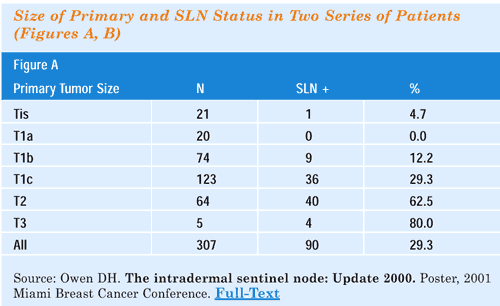|
You
are here: Home: BCU 5|2001: Section 3

DEFINING MICROMETASTATIC DISEASE
The false-negative rate of conventional axillary dissection is
about 15 percent,even in the hands of really good breast pathologists
like Peter Rosen.The false-negative rate with sentinel lymph node
mapping is likely to be in the range of five percent. In our own
experience and in other centers, we are finding more metastatic
disease per tumor size in this era than in the past. So, not only
would I argue that sentinel node mapping is less surgery, but it’s
actually finding more N1 disease that the medical oncologist can
appropriately treat.Where this becomes problematic is that as we
see lesser and lesser volumes of either cancer cells or extrinsic
cells in the sentinel lymph node, where do we draw the line? The
conventional division of two millimeters or less being micrometastatic
disease is really artificial in the era of sentinel lymph node biopsy.
The nation is divided right now concerning the relevance of IHC-
positive disease and axillary nodes. At one end of the spectrum
are clinicians who say, “We don’t know what this means,
so we shouldn’t do the test. ” There’s also an American
College of Surgeons ’trial where the clinician and the patient
are being blinded to IHC- positive disease. At the other end of
the spectrum — which is where we are — clinicians are
using this information on a case--by-case basis to treat patients.
In the main, the overwhelming evidence is that micrometastatic disease
really is clinically relevant. But, as we saw with tumor size in
the breast, there’s a range. One cell in the lymph node cannot
possibly have the same clinical ramifications as a cluster of cells
or a millimeter of cells. So, fine-tuning that is where the research
is currently aimed.
—Patrick Borgen, MD


Select Publications
Page
2 of 3
Previous page | Next
page
|
|
